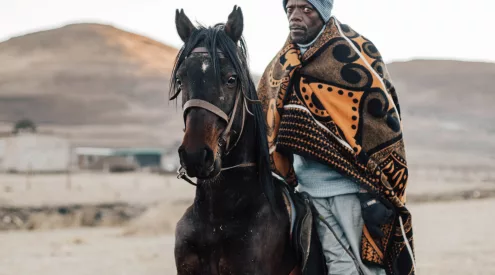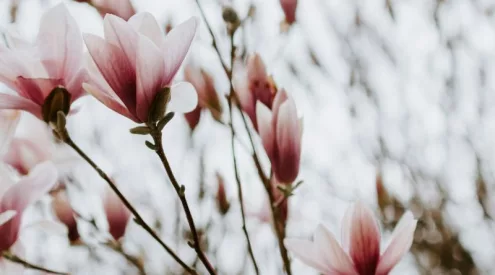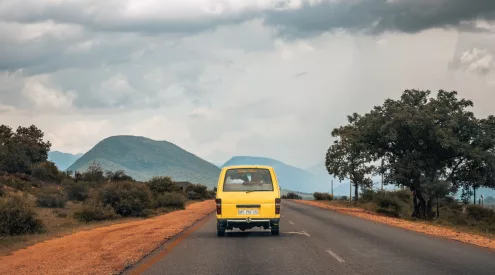The Wildlife Photographer of the Year competition seeks to showcase the world’s best nature photography and photojournalism. The photographs are meant to challenge viewers to consider both their place in the natural world and highlight the responsibility to protect it.
The competition’s overall winners will be announced on 16 October at an awards ceremony in the iconic Hintze Hall in London’s Natural History Museum. Winning images are selected for their creativity, originality and technical excellence and this year’s competition attracted over 45,000 entries from professionals and amateurs across 95 countries.
Ian Owens, Director of Science at the Natural History Museum and member of the judging panel, says, ‘We were captivated by the outstanding quality of the images entered into this year’s competition, which spoke volumes to us about the passion for nature shared by talented photographers across the world. I look forward to seeing the winning selection on beautiful lightbox displays in the exhibition. I’m sure the images will surprise and inspire our visitors, and raise awareness for threatened species and ecosystems.’
Here are 14 finalists from this year’s Wildlife Photographer of the Year.
1. Glass-house guard by Wayne Jones, Australia

Photography by Wayne Jones, Wildlife Photographer of the Year.
On the sandy seabed off the coast of Mabiniin the Philippines, a yellow pygmy goby guards its home – a discarded glass bottle. It is one of a pair, each no more than 4 centimetres (1 and a half inches) long, that have chosen a bottle as a perfect temporary home. The female will lay several batches of eggs, while the male performs guard duty at the entrance. Setting up his camera a few centimetres in front of the bottle’s narrow opening, Wayne positioned his two strobes – one at the base of the bottle to illuminate the interior, and the other at the front to light the goby’s characteristic surprised face. Opting for a shallow depth of field, Wayne focused on the goby’s bulging blue eyes, allowing the movement of the fish to blur the rest of its features into a haze of yellow, and framing its portrait with the circular entrance to the bottle.
2. Mister Whiskers by Valter Bernardeschi, Italy

Photography by Valter Bernardeschi, Wildlife Photographer of the Year.
It was a bright summer’s night when Valter came across the walruses. They were feeding just off an island in the Norwegian archipelago off Svalbard. Putting on his wetsuit, and using a couple of monopod poles and a float to extend his camera in front of him, Valter slipped into the icy water. Immediately, a few curious walruses – mainly youngsters – began swimming towards him. Clumsy on land, these weighty giants now moved with ease and speed. Keeping at pole’s length, he was able to take this intimate portrait of the distinctive whiskered faces of a youngster and its watchful mother. Walruses use their highly sensitive whiskers and snout to search out bivalve molluscs (such as clams) and other small invertebrates on the ocean floor. In the cold water, their thick protective skin appears grey when blood flow to its surface is reduced, but darker, reddish brown when they are out of water and have warmed up. The tusks are not used for feeding but for display among the males, for defence against polar bears and for hauling themselves out, especially onto sea ice. They will rest on ice floes between bouts of feeding and even give birth on them.
3.Looking for love by Tony Wu, United States

Photography by Tony Wu, Wildlife Photographer of the Year.
Accentuating his mature appearance with pastel colours, protruding lips and an outstanding pink forehead, this Asian sheepshead wrasse sets out to impress females and see off rivals, which he will head-butt and bite. Tony has long been fascinated by the species’ looks and life history. Individuals start out as females, and when they reach a certain age and size – up to a metre (more than 3 feet) long – can transform into males. Long-lived and slow-growing, the species is intrinsically vulnerable to overfishing. It favours rocky reefs in cool waters in the Western Pacific, where it feeds on shellfish and crustaceans, though little more is known about it. In a window of calm, amid high seas, Tony reached Japan’s remote Sado Island, to reveal some of the drama of the wrasses’ lives. Here, he conveys the suitor’s earnest intentions, written large on his face.
4. Delta design by Paul Mckenzie, Ireland/Hong Kong

Photography by Paul Mckenzie, Wildlife Photographer of the Year.
Flying over the Southern Ewaso Ng’iro River delta, on the border of Kenya and Tanzania, Paul was mesmerized by the network of tendrils, tinged green with algae, spreading through the river sediment. A far fainter latticework traced the trails made by lesser flamingos as they fed. Every year for the past 12 years, Paul has flown over the delta, observing its constant reshaping due to fluctuating rainfall and deposits of silt and sand. Flowing south through Kenya, the river empties into the caustic waters of Lake Natron in northern Tanzania, a major breeding site for lesser flamingos, which rely on the river’s fresh water for drinking and for cleaning the salt from their feathers. As his small plane flew over the fern one final time, Paul framed his shot through the open door, battling against turbulence to capture nature’s silt and water composition.
5. Ahead in the game by Nicholas Dyer, UK

Photography by Nicholas Dyer, Wildlife Photographer of the Year.
A pair of African wild dog pups play a macabre game of tag with the head of a chacma baboon – the remains of their breakfast. The endangered African wild dog (aka the painted hunting dog) is best known for hunting antelopes, such as impalas and kudus. But over the past five years, in Mana Pools National Park, northern Zimbabwe, Nick has witnessed three different packs regularly killing and eating baboons – highly unusual, not least because baboons are capable of inflicting severe wounds. The hunting technique has been perfected by Blacktip, mother of the pups and the alpha female of the Nyakasanga pack. That morning, Nick had tracked a pack on foot for 3 kilometres (nearly 2 miles), taking in two failed impala hunts before the dogs finally seized a baboon. It wasn’t enough to feed the whole pack, but it satisfied nine pups. They stopped short of the baboon’s skull, and then the fun began. Nick, lying nearby, watched more than half an hour of chasing, tackling and tugs of war with the leftovers.
6. Cool cat by Isak Pretorius, South Africa

Photography by Isak Pretorius, Wildlife Photographer of the Year.
A lioness drinks from a waterhole in Zambia’s South Luangwa National Park. She is one of the Mfuwe Lodge pride – two males, five females and five cubs. Isak had been keeping watch on them while they slept off a feast from a buffalo kill the night before. Lions kill more than 95 per cent of their prey at night and may spend 18–20 hours resting. When this female got up and walked off, Isak anticipated that she might be going for a drink, and so he headed for the nearest waterhole. Though lions can get most of the moisture they need from their prey and even from plants, they drink regularly when water is available. Isak positioned his vehicle on the opposite side of the waterhole, close to the edge, steadying his long lens in the low light on a bean bag. Sure enough, the lioness appeared through the tall, rainy-season grass and hunched down to drink, occasionally looking up or sideways. With perfect timing, Isak caught her gaze and her tongue, lapping the water, framed by the wall of lush green.
7. Witness by Emily Garthwaite, UK

Photography by Emily Garthwaite, Wildlife Photographer of the Year.
As soon as he saw Emily, the sun bear hurried to the front of his filthy cage. ‘Every time I moved, he would follow me.’ He was just one of several sun bears kept behind the scenes at a zoo in Sumatra, Indonesia, in conditions Emily says were ‘appalling’. Sun bears are the world’s smallest bears, now critically endangered. In the lowland forests of Southeast Asia, they spend much of their time in trees, eating fruit and small animals, using their claws to prise open rotten wood in search of grubs. They are threatened by rampant deforestation and the demand for their bile and organs for traditional Chinese medicine. People involved in illegal logging and clearance for oil palms are also linked to animal trafficking. When this sun bear saw the keeper, he started screaming. It was a chilling noise. Even more chilling was the nearby taxidermy museum with its stuffed pangolins and Sumatran tigers.
8. Tigerland by Emmanuel Rondeau, France

Photography by Emmanuel Rondeau, Wildlife Photographer of the Year.
In a remote forest, high in the Himalayas of central Bhutan, a Bengal tiger fixes his gaze on the camera. The path he treads is part of a network linking the country’s national parks – corridors that are key to the conservation of this endangered subspecies but unprotected from logging and poaching. Emmanuel and a team of rangers climbed rugged terrain, with enough kit to set up eight still and eight video cameras along one route, in the hope of glimpsing a tiger pass by (there were just 103 in Bhutan at the last count). Concentrating on areas with previous tiger records, they searched for evidence of recent use – tracks, scratches and faeces – and then Emmanuel installed cameras on wooden posts in the most likely spots, composing the view so the subject would be framed within its mountain environment. After 23 days (and hundreds of false triggers by leaves and high winds), he hit the jackpot: a magnificent male tiger, and from his distinctive stripe pattern, one previously unrecorded in Bhutan. The tiger inspected the kit closely before disappearing into the forest, leaving this rare image, as if looking to us to protect his realm.
9. Forest on a tree by Antonio Fernandez, Spain

Photography by Antonio Fernandez, Wildlife Photographer of the Year.
The arms of immense trees stretched eerily into the mist permeating Madeira’s Fanal Forest. Among them was this low tilo branch with ferns growing all along it, ‘like a forest within a forest’, says Antonio. The mighty tilo tree – an evergreen laurel which can reach more than 40 metres (130 feet) tall – is found only in Madeira and the Canary Islands. It is a dominant element of the island’s laurisilva – the largest relic of the laurel forest that once extended across southern Europe and northwestern Africa. Now threatened mainly by invasive species, this humid expanse is home to a wealth of plants and animals, many of them found nowhere else. Key to Antonio’s miniature forest was the hare’s foot fern, with broad, finely-divided fronds. It occurs in the western Mediterranean, Canary Islands and Madeira. Like other epiphytes (plants that grow on other plants), it garners water and nutrients from the air, rain or plant debris and relies on the host plant for support. As the breeze threaded through the trees, it stirred up the ubiquitous fog, frustrating Antonio’s desire for a uniformly intense backdrop. But in a moment of calm, he realized the simple elements of his composition, isolated against pure white.
10. School visit by Adrian Bliss, UK

Photography by Adrian Bliss, Wildlife Photographer of the Year.
Adrian was exploring the derelict schoolroom when the red fox trotted in, perhaps curious about the human or perhaps just on its rounds. It stopped briefly on the carpet of child-sized gas masks, just long enough for a picture, and then exited through a broken window. The school in Pripyat, Ukraine, was abandoned in 1986, as was the whole city, following the catastrophic explosion at the Chernobyl nuclear power plant, just 3 kilometres (nearly 2 miles) away. It was the worst nuclear accident in history, spreading radioactive fallout across Europe. Pripyat’s buildings are now decaying and have been looted (the gas masks – Cold War relics – were left as being of no value). The city lies within the 30-kilometre (19-mile) exclusion zone, which only accredited individuals can enter, and in the absence of humans, the forest is moving back in. Animals such as wild boar, deer, moose and lynx are making a comeback, and there are even sightings of brown bears and wolves. Though there were areas of the zone that Adrian was advised not to enter because radiation levels were still too high, and though the long-term effect of radiation on the animals is far from clear, wildlife appears to be thriving.
Although these images are great, we are a little biased and think that the entries that we have recieved for the 2018 Getaway Gallery Photographic Competition, in association with Canon South Africa, supercede these.
There’s still time to enter, so don’t miss out on your chance to win a trip to Madagascar and fantastic photographic gear.



































